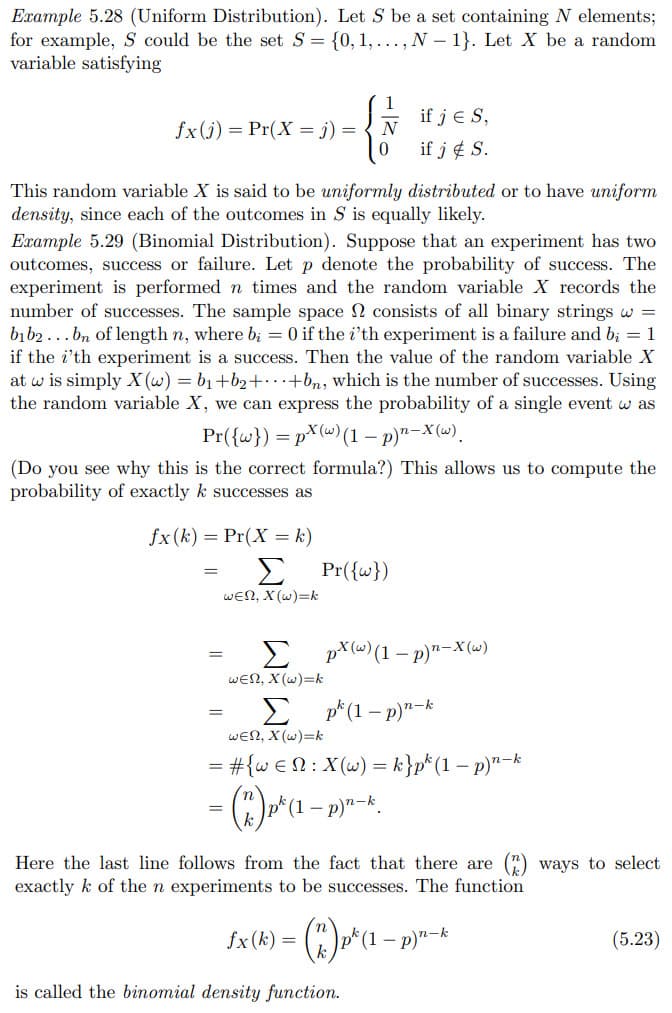5.34. In each case, compute the expectation of the random variable X. (a) The values of X are uniformly distributed on the set {0, 1, 2, ..., N-1}. (See Example 5.28.) (b) The values of X are uniformly distributed on the set {1, 2,..., N}. (c) The values of X are uniformly distributed on the set {1, 3, 7, 11, 19, 23). (d) X is a random variable with a binomial density function; see formula (5.23) in Example 5.29 on page 240.
5.34. In each case, compute the expectation of the random variable X. (a) The values of X are uniformly distributed on the set {0, 1, 2, ..., N-1}. (See Example 5.28.) (b) The values of X are uniformly distributed on the set {1, 2,..., N}. (c) The values of X are uniformly distributed on the set {1, 3, 7, 11, 19, 23). (d) X is a random variable with a binomial density function; see formula (5.23) in Example 5.29 on page 240.
College Algebra
7th Edition
ISBN:9781305115545
Author:James Stewart, Lothar Redlin, Saleem Watson
Publisher:James Stewart, Lothar Redlin, Saleem Watson
Chapter9: Counting And Probability
Section9.3: Binomial Probability
Problem 2E: If a binomial experiment has probability p success, then the probability of failure is...
Related questions
Question
[Algebraic Cryptography] How do you solve this? Second picture is for context

Transcribed Image Text:Example 5.28 (Uniform Distribution). Let S be a set containing N elements;
for example, S could be the set S = {0, 1,..., N-1}. Let X be a random
variable satisfying
1
fx(j) = Pr(X= j) = N
This random variable X is said to be uniformly distributed or to have uniform
density, since each of the outcomes in S is equally likely.
Example 5.29 (Binomial Distribution). Suppose that an experiment has two
outcomes, success or failure. Let p denote the probability of success. The
experiment is performed n times and the random variable X records the
number of successes. The sample space 2 consists of all binary strings w =
bib2.bn of length n, where b; = 0 if the i'th experiment is a failure and bį = 1
if the i'th experiment is a success. Then the value of the random variable X
at w is simply X (w) = b₁+b₂+ +bn, which is the number of successes. Using
the random variable X, we can express the probability of a single event was
Pr({w})= px (w) (1 - p)n-X(w).
(Do you see why this is the correct formula?) This allows us to compute the
probability of exactly k successes as
fx (k)= Pr(X= k)
Σ
WEN, X(w)=k
=
=
=
Pr({w})
=
if j = S,
if j & S.
Σ p*(w)(1 −p)"-
WEN, X(w)=k
Σp (1-p)n-k
WEN, X(w)=k
= # {w EN: X(w) = k}pk (1-p)n-k
() ₁² (1)
)n-X (w)
fx (k) = (7) ₁² (1–
Here the last line follows from the fact that there are (2) ways to select
exactly k of the n experiments to be successes. The function
is called the binomial density function.
- p)n-k
(5.23)

Transcribed Image Text:5.34. In each case, compute the expectation of the random variable X.
(a) The values of X are uniformly distributed on the set {0, 1, 2,..., N-1}. (See
Example 5.28.)
(b) The values of X are uniformly distributed on the set {1,2,..., N}.
(c) The values of X are uniformly distributed on the set {1, 3, 7, 11, 19, 23}.
(d) X is a random variable with a binomial density function; see formula (5.23) in
Example 5.29 on page 240.
Expert Solution
This question has been solved!
Explore an expertly crafted, step-by-step solution for a thorough understanding of key concepts.
This is a popular solution!
Trending now
This is a popular solution!
Step by step
Solved in 2 steps with 2 images

Recommended textbooks for you

College Algebra
Algebra
ISBN:
9781305115545
Author:
James Stewart, Lothar Redlin, Saleem Watson
Publisher:
Cengage Learning

Algebra & Trigonometry with Analytic Geometry
Algebra
ISBN:
9781133382119
Author:
Swokowski
Publisher:
Cengage

College Algebra
Algebra
ISBN:
9781305115545
Author:
James Stewart, Lothar Redlin, Saleem Watson
Publisher:
Cengage Learning

Algebra & Trigonometry with Analytic Geometry
Algebra
ISBN:
9781133382119
Author:
Swokowski
Publisher:
Cengage